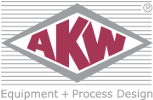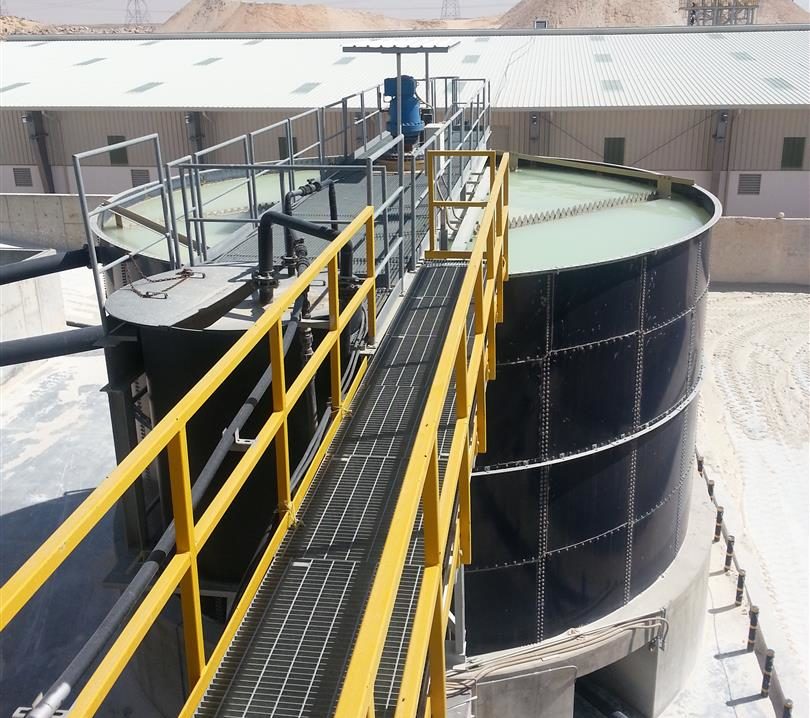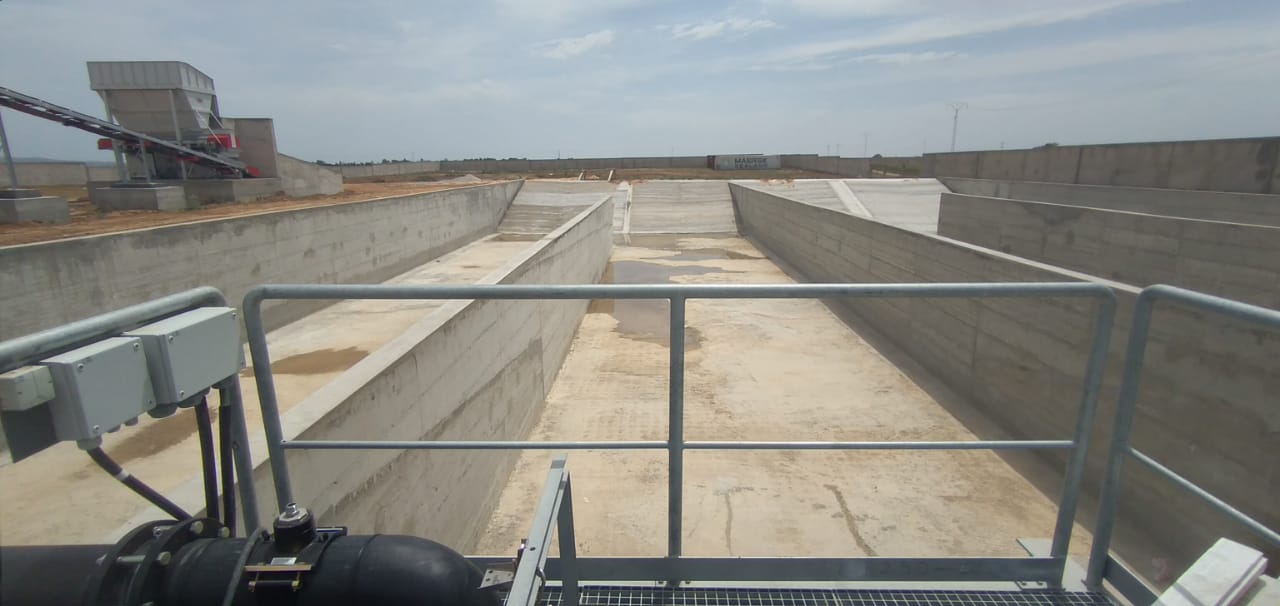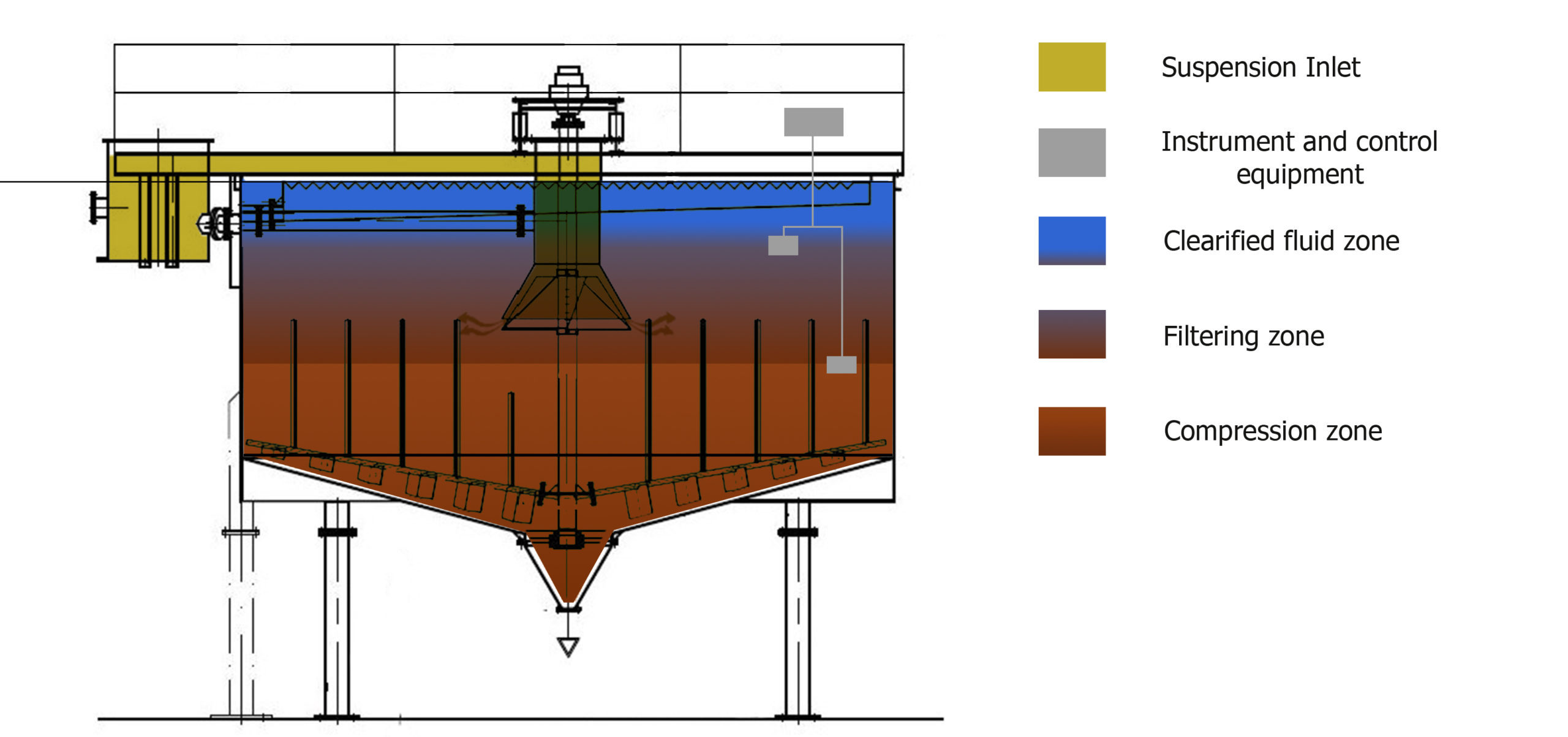[1] Thickener AKA-SET for process water clarification and slurry thickening / flat-bottom version
AKW Equipment + Process Design’s customized process water recycling concepts:
a pragmatic solution for each client environment
Water – the most fundamental of natural resources – is indispensable in our daily business as we strive to design the best-in-class wet mechanical treatment systems. By using less and recycled water we cannot only save money spent for fresh water we also save energy, thus supporting the reduction of greenhouse gases.
Mining operations require large amounts of water and generate tailing wastes which make a major toll on the environment. AKW Equipment + Process Design R&D department has been intensively involved in developing technologies that help quarrying, mining and processing companies to optimize their water consumption and extract value from tailings waste.
However, since companies do not all have the same challenges and limitations, the customizing of the process water solutions shows to be paramount in the customer’s decision : key is not to over engineer a solution, but to find the right balance and value proposition between the need to recycle water and the given customer environment.
We see it as our responsibility
AKW Equipment + Process Design has developed several concepts that allow more economic and environment friendly mining operations, by focusing on making water recycling efficient and allowing to extract more value from tailings by turning these leftover materials into valuable products. Thus, the overall environmental footprint can be minimized, while ensuring sustainable operations for the customer.
“Our solutions have been firmly established on the market and receive, especially in the current times, steadily increasing interest.”
In the wet mechanical treatment route, the process water contains a high amount of fine particles, ideally <63µm but in many cases seen as 100µm, carried over from attritioning, desliming and classification of the raw materials (so-called TSS – Total Suspended Solid). In order to recycle the process water, the suspended solids have to be separated in physical process using the gravity force and providing the required settling area by determining the settling velocity, as well as the retention and detention times needed to settle the suspended particles in a smooth flow, stable state and with no turbulence.
In some cases, to reduce the settling area and increase the clarity of the water a chemical process can be integrated by utilizing environmental-friendly organic chemicals (so-called flocculants) which will help bonding the fine particles to generate bigger flocs. As in the physical process, the micro particles (<10µm) are unlikely separated by the standard gravity, this chemical additives will significantly reduce the TSS in the process water which will increase the settling speed leading to less retention time and minimize the required settling area.
To determine the settling velocity and to dimension the required settling area, AKW Equipment + Process Design technical laboratory performs different tests on the process water. By considering the design parameters such as the feed flowrate and solids concentration, the settling speed can be determined by running number of tests using different types of flocculants. The results will be compared to design the most efficient settling process, also to give the recommendation of the best efficient and economic choice of the suitable additives in order to maximize the customer benefits.
To find the perfectly suitable process water recycling solutions for the customer´s constraints and opportunities, there are different options to be considered for further investigation:
-
- Water lagoon
- Sedimentation ponds
- Thickeners, type AKA-SET
Water lagoon
A water lagoon is a natural shaped settling area. It is cost-effective and needs less energy, but due to the fact that this solution requires more surface area than other treatment methods, the feasibility depends a lot on the location. Especially also the excavation of the sludge once it has settled down could become complicated. In addition, there are several conditions to be considered, such as climate : in cold climates a water lagoon is sometimes not the preferred solution, unless one accepts to stop most of its operations for several month or work at a slower pace during the winter period.
Key Facts – Water Lagoon:
| Energy Consumption: | Low |
| Efficiency: | Recycling process water up to 70%. Some water loss due to evaporation caused by the surface area |
| Footprint Requirements: | Large |
| Areas of Application: | For clarifying all types of slurries from quarrying and mining beneficiation processes |
| Special Areas of Application: | In locations where large area is available, not for cold climates, with no high wind speed |
| Grain Size of Feed: | Typically < 100µm |
| Discharge Solids Concentration: | approx. 800 -1150g/l |
| Environmental Impact: | High Large space requirement of sludge is destructive to the natural landscape |
| CAPEX: | Low |
| OPEX: | Intermediate |
| Remarks: | Tailings management and materials handling require longer time compared to other options |
Sedimentation pond
With a more limited area, but the desire for a water treatment system given, compact sedimentation ponds are a definite proven solution. Such ponds are dimensioned by the team of AKW Equipment + Process Design and usually made directly by the customer out of concrete, resulting in a long life-time for a low Capex requirement. With the addition of flocculants to the waste water, the settling efficiency can be enhanced. The sedimentation pond is cleaned up from the sludge that settled down on regular basis, in a easy way e.g by using a wheel loader or crane.
[2] Sedimentation Pond made out of concrete
Key Facts – Sedimentation Pond:
| Energy Consumption: | Low |
| Efficiency: | Recycling process water up to 80%. Some water loss due to evaporation caused by the surface area |
| Footprint Requirements: | Pond design is compact, with specific water circuit that optimizes the settling area |
| Areas of Application: | For clarifying all types of slurries from quarrying and mining beneficiation processes |
| Special Areas of Application: | In locations where space is not under constraint |
| Grain Size of Feed: | Typically < 100µm |
| Discharge Solids Concentration: | approx. 800 -1150g/l |
| Environmental Impact: | Minimized |
| CAPEX: | Average (concrete work only) |
| OPEX: | Intermediate |
| Remarks: | Better tailings management and materials handling compared to water lagoon
Pond design can be engineered by AKW Equipment + Process Design to combine twin ponds, working in sequence for continuous plant operation (1 pond running, while the other is being cleaned up) |
Thickener, type AKA-SET
For optimum clarification and thickening effects, as well as minimum space requirement, a thickener, type AKA-SET can be integrated into the plant. The AKA-SET is a high performance thickener, where he flocculated feed slurry is fed from the top in the center of the thickener tank. There, macro flocs will be created in the filtering zone, by having the flocculated feed slurry flowing in counter-current to the particles that sediment.
By engineering the interactions between the flocculant and the particles in such way, these flocs will sediment at a higher speed than the micro flocs of conventional thickeners. This results in a higher loading rate per unit settling area and smaller thickener diameters.
Additionally and contrarily to most of the known thickener types, the rake system of the AKA-SET series covers the complete thickener diameter and not only its radius, hence ensuring a better de-aeration and compacting of the sludge before it is being discharged.
[3] Thickener AKA-SET settling regimes depend on compressing particles and reducing the volume of tailings
The customized designed thickeners are manufactured out of corrosion-resistant materials (steel, stainless steel) and can be coated in rubber, polyurethane or ceramic glazed for highest wear resistance and maximum lifetime. Compared to the clearing procedure of a sedimentation pond, this system is more automated and can clear the sludge through a self-controlled pump.
After a thickener, is usually installed a sludge pond or in some cases filter press systems, although those can sometimes represent a heavy investment.
Depending on the nature of the processed material and the value of the thickened sludge, the AKA-SET series are available in two different designs:
Conical Version
The scope of supply of the conical version ranges from 2.8 m diameter up to 18.0 m diameter, and is typical used in the mining, kaolin, clays and salts industries, where sludge is a valuable mineral that sometimes is also further processed.
Flat-Bottom Version
The flat-bottom version is available from 8.0 m diameter up to 18.0 m diameter and typically used for sands, slags and soil remediation, where dead zones of sludge matter less.

[4] Thickener AKA-SET conical version |

[5] Thickener AKA-SET flat-bottom version |
Key Facts – Thickeners AKA-SET:
| Energy Consumption: | Average |
| Efficiency: | High efficiency in recycling process water up to 90% |
| Footprint Requirements: | Limited area |
| Areas of Application: | For clarifying all types of slurries from quarrying and mining beneficiation processes |
| Special Areas of Application: | In locations with limited area, in cold climate or strong winds, the thickener can also be installed indoor due to small footprint |
| Grain Size of Feed: | Typically < 100µm |
| Discharge Solids Concentration: | approx. up to 600 g/l |
| Environmental Impact: | Efficient tailings management
Suitability for small scale mining: in small mines, thickeners are the most common method for clarification of tailings that are rich in suspended solids |
| CAPEX: | Intermediate |
| OPEX: | Intermediate |
| Remarks: | Minimizing tailings management and material handling time by compacting efficiently the volume of waste material
Can be coupled with sludge tank and filter press system, to further optimize the process water recovery and sludge disposal. |
Overall, it can be concluded that there is no unique solution for process water management strategy. Depending on the customer situation, its flexibilities and constraints, its investment capabilities but also depending on the nature of the sludge itself and its further treatment steps, specific proven solutions can be engineered and offered by AKW Equipment + Process Design. Being understood that all solutions do support and contribute to the environment protection, by allowing the reuse of process water as well as a reasonable handling of the sludge resulting from the mineral treatment.
About AKW Equipment + Process Design
AKW Equipment + Process Design is an internationally oriented specialist for process technology, engineering, equipment as well as plant construction and service in the field of wet mechanical mineral processing and environmental technology. Based on its process engineering developments, the company offers practice-oriented and individually tailored solutions in all stages of the value chain. Process development and plant engineering from AKW Equipment + Process Design are based on many years of experience, professionalism and know-how.
www.akwauv.com
https://www.pinterest.de/AKWApparateundVerfahren/thickeners/



